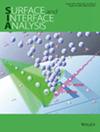Surface analysis insight note: An example of a cluster analysis of spectra from an X-ray photoelectron spectroscopy image
IF 1.8
4区 化学
Q4 CHEMISTRY, PHYSICAL
引用次数: 0
Abstract
Identification of similar and dissimilar spectra is an important part of analyzing X-ray photoelectron spectroscopy (XPS) images. Cluster analysis (CA) is a commonly used exploratory data analysis (EDA) method that groups similar spectra in a data set. CA can be performed in either an agglomerative fashion, for example, using Ward's method, which involves successively linking together/clustering the most similar spectra in a data set, or in a divisive fashion, for example, using the K-means approach, which involves partitioning all the data into a specified number of clusters. In this note, we show the application of CA to an XPS image dataset. The use of Ward's method identified two major clusters in the image, where one of the clusters appeared as two subclusters. The K-means image based on two clusters agrees well with previous analyses of the same image. The average spectra corresponding to clusters helped confirm the assignments made by the CA algorithms, as did a multivariate curve resolution (MCR) analysis of the interior region identified in our cluster analysis. “Elbow” plots can help determine the number of clusters to keep in K-means clustering. The combination of the agglomerative and divisive forms of CA, where the first informs the second, can be effective in revealing the structures of XPS image datasets. The Procrustean bed is a metaphor for overfitting and underfitting in EDA.表面分析洞察注:x射线光电子能谱图像的光谱聚类分析示例
相似和不同光谱的识别是分析x射线光电子能谱(XPS)图像的重要组成部分。聚类分析(CA)是一种常用的探索性数据分析(EDA)方法,它将数据集中相似的光谱进行分组。CA可以以聚集方式执行,例如,使用Ward的方法,它涉及到将数据集中最相似的光谱依次连接在一起/聚类,或者以分裂方式执行,例如,使用K-means方法,它涉及到将所有数据划分到指定数量的聚类中。在本文中,我们将展示CA对XPS图像数据集的应用程序。使用Ward的方法在图像中识别出两个主要簇,其中一个簇以两个子簇的形式出现。基于两个聚类的K-means图像与先前对同一图像的分析非常吻合。与聚类对应的平均光谱有助于确认CA算法所做的分配,正如我们在聚类分析中确定的内部区域的多元曲线分辨率(MCR)分析一样。“肘形”图可以帮助确定K-means聚类中需要保留的聚类数量。CA的凝聚和分裂形式的结合,其中第一种形式通知第二种形式,可以有效地揭示XPS图像数据集的结构。Procrustean床是EDA中过拟合和欠拟合的隐喻。
本文章由计算机程序翻译,如有差异,请以英文原文为准。
求助全文
约1分钟内获得全文
求助全文
来源期刊

Surface and Interface Analysis
化学-物理化学
CiteScore
3.30
自引率
5.90%
发文量
130
审稿时长
4.4 months
期刊介绍:
Surface and Interface Analysis is devoted to the publication of papers dealing with the development and application of techniques for the characterization of surfaces, interfaces and thin films. Papers dealing with standardization and quantification are particularly welcome, and also those which deal with the application of these techniques to industrial problems. Papers dealing with the purely theoretical aspects of the technique will also be considered. Review articles will be published; prior consultation with one of the Editors is advised in these cases. Papers must clearly be of scientific value in the field and will be submitted to two independent referees. Contributions must be in English and must not have been published elsewhere, and authors must agree not to communicate the same material for publication to any other journal. Authors are invited to submit their papers for publication to John Watts (UK only), Jose Sanz (Rest of Europe), John T. Grant (all non-European countries, except Japan) or R. Shimizu (Japan only).
 求助内容:
求助内容: 应助结果提醒方式:
应助结果提醒方式:


